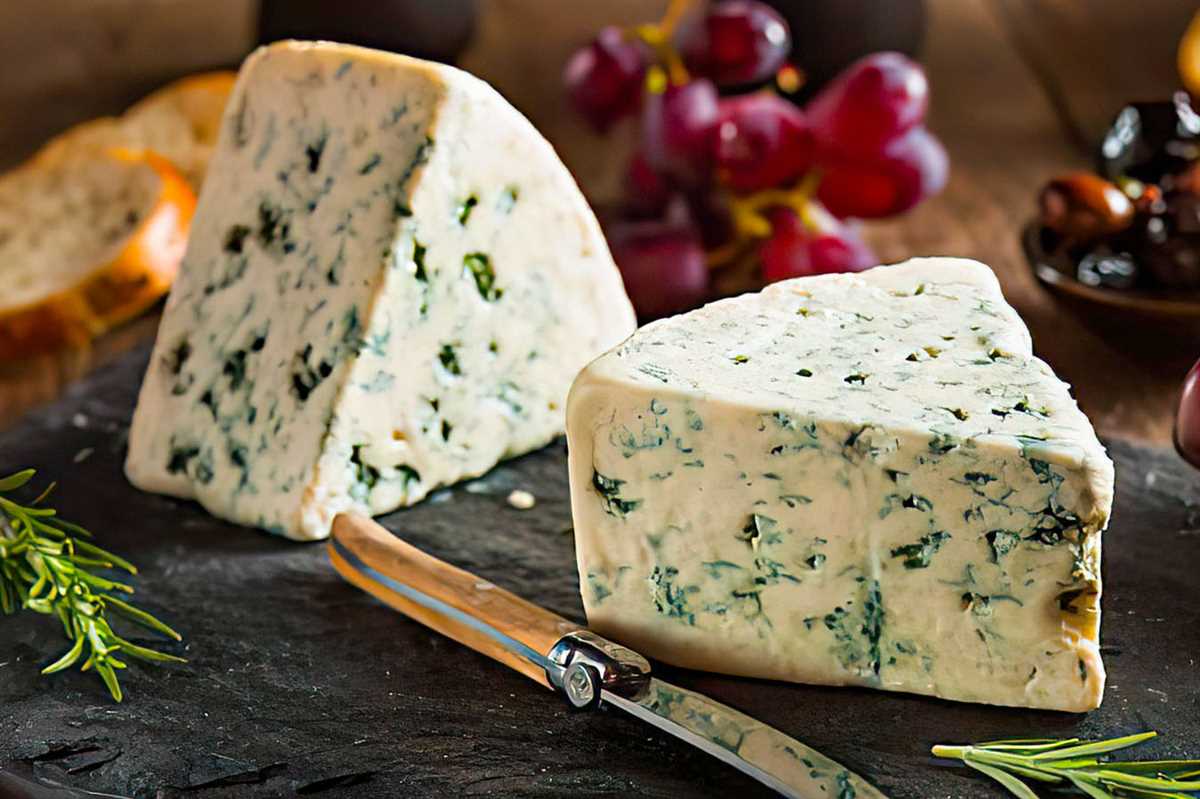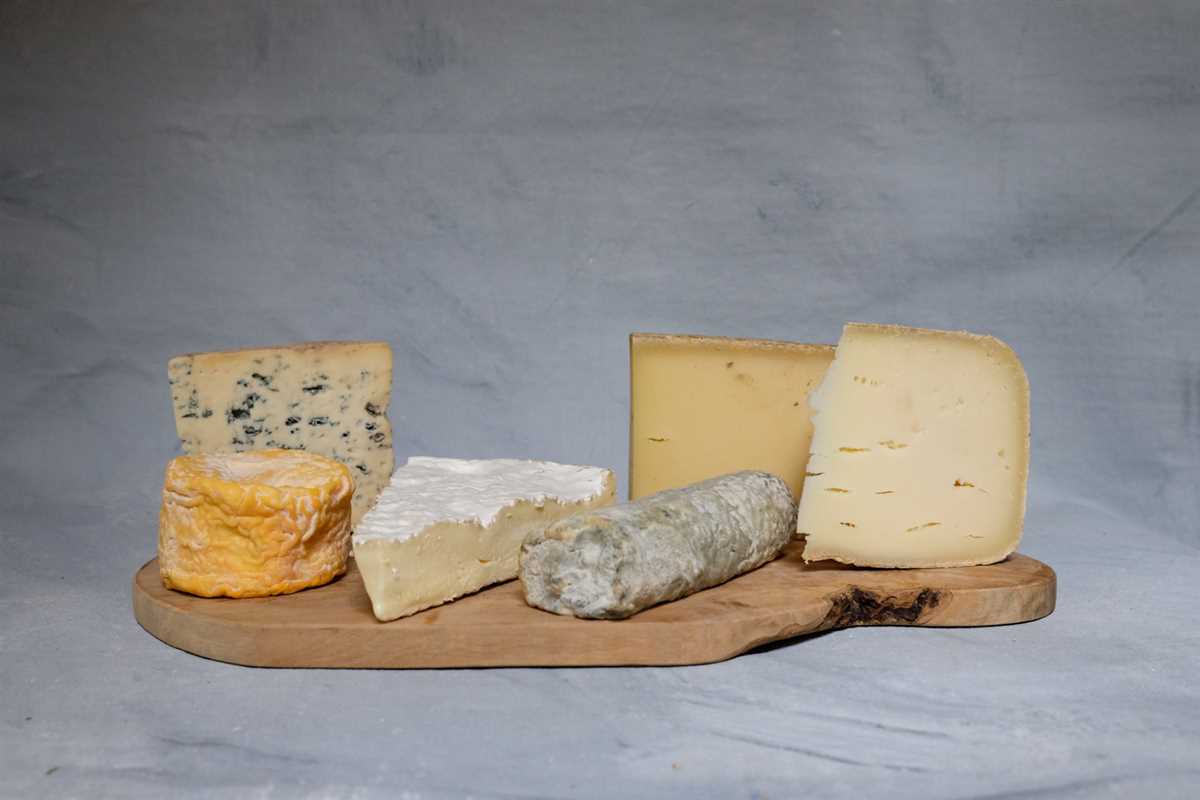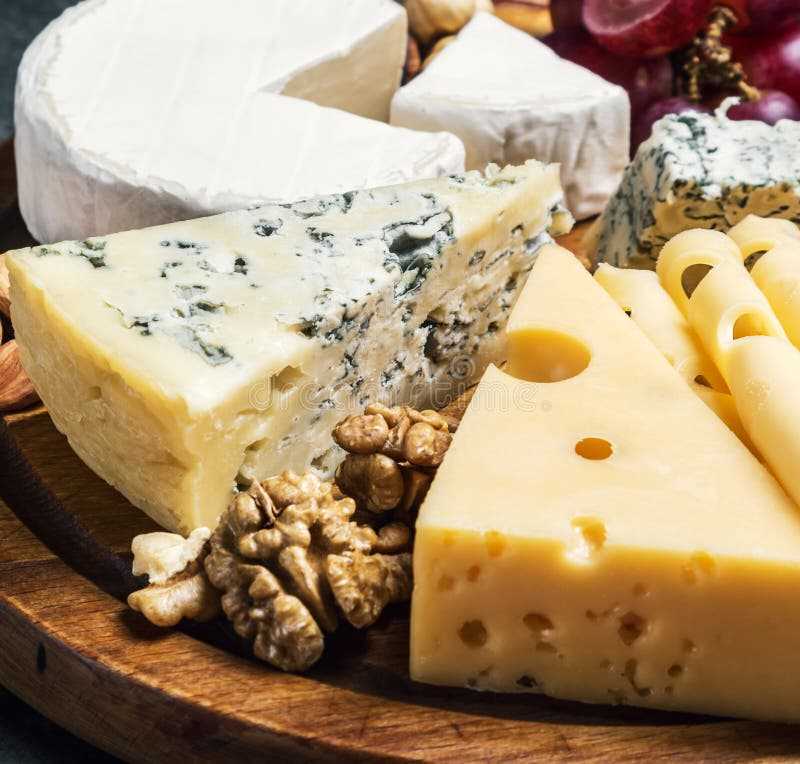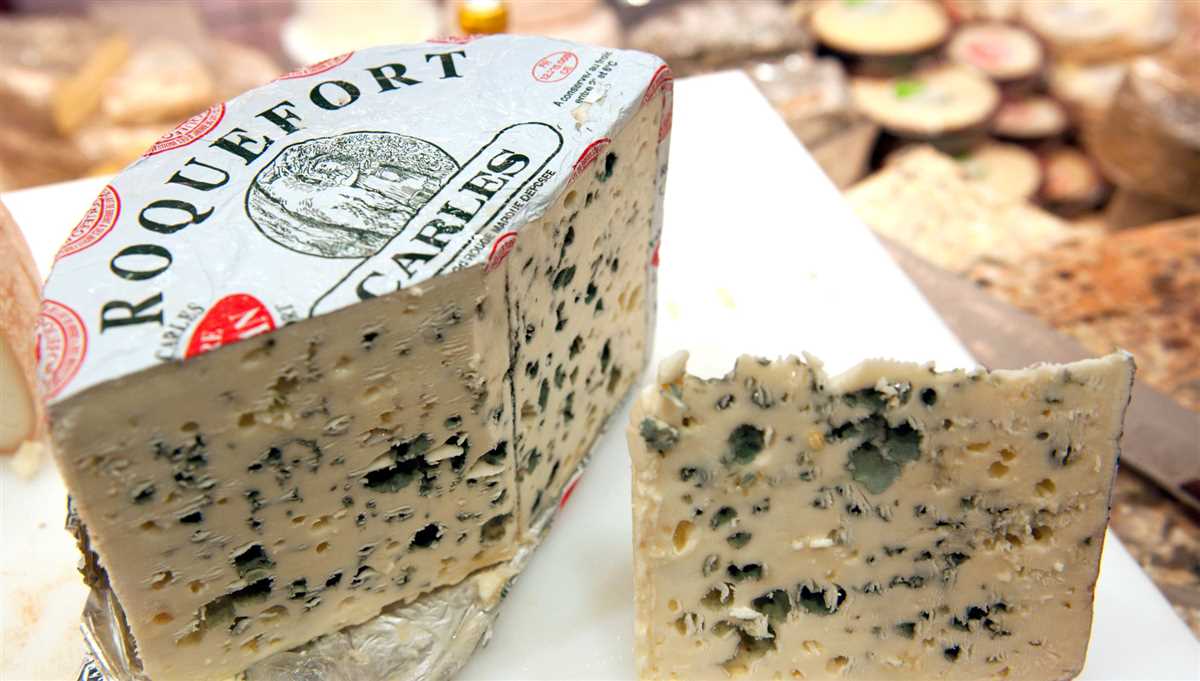
Roquefort and Brie are both types of French cheese that have gained worldwide recognition and popularity. These cheeses are known for their unique flavors and textures, and are often enjoyed as a part of a cheese platter or used in various culinary creations.
Roquefort is a type of blue cheese that is made from sheep’s milk. It has a crumbly texture and a distinct sharp and tangy flavor. The cheese is aged in natural limestone caves in the Roquefort-sur-Soulzon region of France, which gives it its unique flavor profile. Roquefort is often crumbled and used to flavor dishes such as salads, sauces, and dressings.
Brie, on the other hand, is a soft-ripened cheese that is made from cow’s milk. It has a creamy texture and a mild, buttery flavor. Brie is typically aged for a shorter period of time compared to Roquefort, which results in a milder taste. The cheese is often enjoyed on its own or paired with fruits, crackers, or bread. Brie is also commonly used in baked dishes and sandwiches.
Both Roquefort and Brie are considered to be delicacies and are highly regarded in the world of cheese. Their unique flavors and textures make them a favorite among cheese lovers. Whether you prefer the tangy and crumbly Roquefort or the creamy and mild Brie, these French cheeses are sure to delight your taste buds.
Roquefort: The Legendary Blue Cheese from France
Roquefort is a legendary blue cheese that originates from the region of Occitanie in southern France. It is considered one of the world’s finest cheeses and is known for its distinctive taste and creamy texture. Roquefort has a long history that dates back to ancient times, and it has been enjoyed by royalty, nobility, and food enthusiasts for centuries.
What sets Roquefort apart from other blue cheeses is its unique production process. The cheese is made from the milk of a specific breed of sheep, the Lacaune sheep, which graze on the fertile land around the village of Roquefort-sur-Soulzon. The milk is collected and then combined with a specific strain of mold, Penicillium roqueforti, which grows naturally in the caves located in this region. The cheese is aged in these caves for at least 90 days, allowing the mold to work its magic and give Roquefort its distinct blue veins and tangy flavor.
Roquefort is known for its complex and intense flavors. It has a creamy, melt-in-your-mouth texture with a sharp and tangy taste. The blue veins running through the cheese add an earthy and slightly salty note. Roquefort pairs incredibly well with fruits like pears and apples, as well as nuts and crusty bread. It is often enjoyed with a glass of sweet wine, such as Sauternes or Port, which helps balance out the strong flavors of the cheese.
In addition to its delicious taste, Roquefort also boasts some health benefits. It is rich in protein, calcium, and vitamin E, making it a nutritious choice for cheese lovers. The unique mold used in the production of Roquefort contains antibacterial properties and is believed to have potential health benefits for the digestive system.
Today, Roquefort is protected by the Appellation d’Origine Contrôlée (AOC) designation, which ensures that only cheese produced in the specific region and using the traditional methods can be called Roquefort. This designation highlights the importance of preserving the heritage and craftsmanship behind this iconic cheese.
Whether enjoyed on a cheese platter, crumbled over salads, or used in cooking, Roquefort is a true culinary treasure that has stood the test of time. Its rich history, unique production process, and delicious flavors make it a must-try for any cheese connoisseur.
Origins and History
Roquefort and Brie are two popular types of cheese that have their own unique origins and history. Both of these cheeses are known for their distinctive flavors and textures, making them highly sought after by cheese enthusiasts around the world.
Roquefort is a type of blue cheese that has been produced in the Roquefort-sur-Soulzon region of France for centuries. Legend has it that Roquefort was discovered by a young shepherd who left his lunch of bread and cheese in a cave while he pursued a beautiful maiden. When he returned, he found that the cheese had developed blue veins and a rich, tangy flavor. This accidental discovery led to the creation of Roquefort cheese, which became a favorite of French royalty and eventually gained international recognition.
Brie is a soft, creamy cheese that originated in the region of Brie, located in northern France. It is believed to have been created during the reign of Charlemagne in the 8th century. Brie was originally made by farmers in the region as a way to preserve excess milk. It quickly gained popularity and was soon being enjoyed by the French nobility. Over the years, Brie has become synonymous with French cuisine and is now produced and enjoyed all over the world.
The production of both Roquefort and Brie involves specific techniques and strict regulations to ensure the highest quality and consistency. Roquefort is made from the milk of the Lacaune breed of sheep, which graze on the unique grasses and herbs found in the region. The cheese is aged in caves that provide the perfect environment for the growth of the blue-green mold that gives Roquefort its distinct flavor and aroma. Brie, on the other hand, is made from cow’s milk and undergoes a process called “blooming,” where the cheese forms a soft, white rind during its aging process.
Today, both Roquefort and Brie are beloved by cheese connoisseurs and are considered iconic French cheeses. They can be enjoyed on their own, as part of a cheese board, or incorporated into various dishes, adding a burst of flavor and sophistication. Whether you prefer the strong, tangy taste of Roquefort or the rich, creamy texture of Brie, these cheeses have a long and fascinating history that adds to their allure.
Production and Aging Process
The production process of both Roquefort and Brie cheeses is a delicate and intricate one that requires careful attention to detail. Both cheeses are made from cow’s milk, although Roquefort can also be made from sheep’s milk. The milk used for both cheeses is sourced from specific regions known for their high-quality dairy products.
For the production of Roquefort cheese, the milk is first heated and mixed with rennet, a coagulating agent. The curd that forms is then cut, drained, and transferred to special molds. Penicillium roqueforti, a type of mold, is added to the curd to give the cheese its distinct blue veins. The cheese is then pierced to allow oxygen to enter, promoting the growth of the mold. After a few weeks, the cheese is removed from the molds and aged in cool, humid caves for several months.
Brie cheese, on the other hand, goes through a slightly different production and aging process. The milk is heated and mixed with starter cultures and rennet. The curd is cut and then transferred to cheese molds. Unlike Roquefort, Brie does not require the addition of mold. Once the cheese is removed from the molds, it is allowed to age in controlled environments for a period of time. The aging process gives Brie its characteristic soft and creamy texture.
Overall, both Roquefort and Brie cheeses undergo careful production and aging processes to achieve their unique flavors and textures. The use of specific molds and aging conditions play a crucial role in the development of these cheeses, making them beloved by cheese enthusiasts around the world.
Characteristics and Flavor Profile

Roquefort and Brie are both famous and distinct types of cheese that offer unique characteristics and flavor profiles.
Roquefort:
- Roquefort is a blue cheese that originates from France and is made from sheep’s milk.
- It is known for its distinct veining, which is created by the addition of the mold Penicillium roqueforti.
- Roquefort has a crumbly texture and a strong, tangy flavor. The blue veins throughout the cheese give it a pungent and slightly salty taste.
- It has a creamy and rich mouthfeel, with hints of earthiness.
- Roquefort’s flavor intensifies with age, becoming sharper and more assertive.
Brie:
- Brie is a soft-ripened cheese that originates from France and is made from cow’s milk.
- It is characterized by its soft and creamy texture, which becomes even runnier as it ages.
- Brie has a bloomy rind, which is soft and often edible.
- It has a mild and buttery flavor, with a slight tanginess and nutty undertones.
- Brie is often described as being rich and velvety, with a delicate and melt-in-your-mouth texture.
While Roquefort and Brie are both popular types of cheese, their flavor profiles and textures are quite distinctive. Roquefort offers a strong and tangy taste with a crumbly texture, while Brie has a milder and buttery flavor with a soft and creamy texture. The two cheeses can be enjoyed on their own or used as ingredients in various dishes, adding depth of flavor and creaminess. Whether you prefer the bold and pungent notes of Roquefort or the subtle and creamy taste of Brie, both cheeses are sure to satisfy any cheese lover’s palate.
Culinary Uses and Pairings

The distinct flavors and textures of Roquefort and Brie make them versatile ingredients in various culinary creations. Both cheeses can be used in both hot and cold dishes, adding richness and complexity to the overall flavor profile.
Roquefort:
Roquefort cheese is often used as a topping or ingredient in salads, adding a tangy and salty element. It pairs particularly well with fruits such as pears, apples, and grapes, as the sweetness of the fruits complements the sharpness of the cheese. Additionally, Roquefort can be melted and incorporated into sauces or dressings to elevate the flavors of dishes like pasta, steaks, and roasted vegetables.
Brie:

Brie is a versatile cheese that can be enjoyed in various ways. It is commonly served as part of a cheese platter or charcuterie board and pairs wonderfully with dried fruits, nuts, and crusty bread. The creamy texture of Brie also makes it an excellent choice for melting, making it a key ingredient in dishes such as baked Brie, quiches, and stuffed pastries. The mild and buttery flavor of Brie makes it an ideal complement to savory ingredients like mushrooms, caramelized onions, and cured meats.
Pairings:
In addition to their individual uses, Roquefort and Brie can be paired with other ingredients to create harmonious flavor combinations. For a decadent appetizer, try combining Roquefort with sliced pears, honey, and walnuts on toasted baguette slices. Brie can be paired with fig jam and prosciutto for a sweet and salty flavor combination, or melted and spread onto a turkey and cranberry sandwich for a twist on a classic.
- Roquefort: salads, fruits, pasta, steaks, roasted vegetables.
- Brie: cheese platter, charcuterie board, dried fruits, nuts, crusty bread, baked Brie, quiches, stuffed pastries.
Health Benefits and Nutritional Value
Roquefort and Brie are both types of cheese that offer various health benefits and pack a nutritional punch. These cheeses are not only delicious and versatile in cooking, but they also provide several essential nutrients that can contribute to a balanced diet.
One of the standout nutritional benefits of Roquefort cheese is its high content of calcium. Calcium is crucial for maintaining strong bones and teeth, and it also plays a vital role in muscle function, nerve transmission, and blood clotting. Incorporating Roquefort cheese into your diet can be an excellent way to ensure you’re getting enough calcium, especially for individuals who may not consume much dairy.
Roquefort Cheese:
- Rich in protein: Roquefort cheese is a great source of high-quality protein. Protein is essential for building and repairing tissues, supporting overall growth and development, and maintaining a healthy immune system.
- Good source of vitamins and minerals: In addition to calcium, Roquefort cheese contains other essential minerals like phosphorus, potassium, and magnesium. It also provides vitamins A, B2, and B12.
- Probiotic properties: Roquefort cheese undergoes a ripening process with the help of a specific mold called Penicillium roqueforti. This mold not only gives the cheese its distinctive flavor but also provides probiotic benefits by promoting a healthy gut microbiome.
Brie Cheese:
Brie cheese, on the other hand, has its own set of health benefits and nutritional value.
- Rich in vitamins: Brie cheese is a good source of vitamins A, B2, and B12. These vitamins play a crucial role in maintaining healthy skin, vision, and red blood cell production.
- Good source of minerals: Brie cheese contains minerals like calcium, phosphorus, and selenium. Phosphorus is important for bone health, while selenium acts as an antioxidant and supports the immune system.
- Conjugated Linoleic Acid (CLA): Brie cheese is known for its conjugated linoleic acid content, which is a type of fatty acid. CLA has been linked to several health benefits, including reducing inflammation, supporting weight loss, and potentially preventing certain types of cancer.
Overall, both Roquefort and Brie cheese can be enjoyed not only for their incredible flavors but also for their contributions to a well-rounded diet. As with any food, moderation is key, and it’s always recommended to consult with a healthcare professional or registered dietitian for personalized nutritional advice.
Brie: The Creamy Delight from France
Brie cheese is a popular and beloved French cheese known for its creamy texture and mild, buttery flavor. It has a long history and has been enjoyed by cheese enthusiasts for centuries. Made from cow’s milk, Brie is named after the region in France where it originated.
Production Process: Brie cheese is made using a specific production process that involves the use of specific molds and bacteria. The milk is first heated and curdled, then it is poured into molds and left to drain. After this, the cheese is salted and aged for a specific period of time, which allows it to develop its unique flavor and texture.
Characteristics: Brie cheese is known for its soft and velvety texture. It has a bloomy rind, which is white in color and edible. The cheese itself is creamy and rich, with a mild and slightly tangy flavor. When fully ripe, the cheese has a distinct aroma that is often described as earthy and mushroom-like.
Pairings: Brie cheese is incredibly versatile and pairs well with a variety of accompaniments. It can be enjoyed on its own, spread on crackers or bread, or used as a topping for salads, sandwiches, and pizzas. Brie also pairs well with fruits like grapes and apples, as well as with nuts and honey.
- Did you know? Brie cheese is often served slightly melted and warm, which enhances its flavor and makes it even creamier.
- Fact: Brie cheese is protected by the French Appellation d’Origine Contrôlée (AOC), which means it can only be called “Brie” if it has been made in a specific region of France using specific ingredients and production methods.
- Fun Fact: Brie de Meaux, a specific type of Brie cheese, was a favorite of French nobility and was famously praised by French Emperor Charlemagne in the 8th century.
In conclusion, Brie cheese is a beloved creamy delight from France. Its unique flavor, creamy texture, and versatility make it a favorite among cheese enthusiasts around the world. Whether enjoyed on its own or paired with other ingredients, Brie cheese is sure to satisfy any cheese lover’s palate.
Q&A:
What is Brie?
Brie is a type of creamy cheese that originated in France.
What does Brie taste like?
Brie has a creamy and buttery flavor with a slight hint of tanginess.
How is Brie made?
Brie is made from cow’s milk and is produced by a process called blooming, where the cheese is inoculated with specific mold cultures and then aged.
Can you eat the rind of Brie?
Yes, the rind of Brie is safe to eat and adds to the flavor and texture of the cheese.